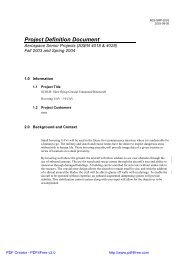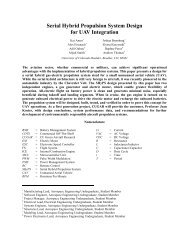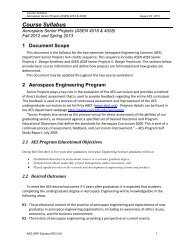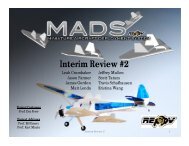PFR - Aerospace Engineering Sciences Senior Design Projects ...
PFR - Aerospace Engineering Sciences Senior Design Projects ...
PFR - Aerospace Engineering Sciences Senior Design Projects ...
Create successful ePaper yourself
Turn your PDF publications into a flip-book with our unique Google optimized e-Paper software.
Project Final Report – CUDBF April 30 th , 2009<br />
ASEN 4028: <strong>Aerospace</strong> <strong>Senior</strong> <strong>Projects</strong><br />
The Neu 1110 2Y motor was chosen because it meets all the requirements at the lightest weight.<br />
In order to increase the torque provided by the motors and increase the efficiency at cruise, the<br />
motor is geared using a gearbox. The two options available for the Neu 1110 motor are a 4.4:1<br />
and 6.7:1 gearbox. According to Electricalc [21] ,amp draw by the Neu 1100 motor using a 4.4:1<br />
gearbox is 60 amps compared to a 24 amp draw with a 6.7:1 gearbox. Since the propulsion<br />
system was designed to utilize up to 40 amps per motor, the 6.7:1 gearbox was eliminated.<br />
Therefore a 4.4:1 gearbox was chosen to provide more torque and increase the efficiency of the<br />
motor at cruise. The motor and gearbox can be seen in Figure 53.<br />
Figure 53: Neu Motor and Gearbox<br />
8.3.2 Propeller<br />
The propeller choice was driven by the requirement to produce enough thrust in order to make<br />
the 100ft takeoff while providing the most efficiency at cruise. The limiting factor in the overall<br />
propeller size was ground clearance. The main landing gear were designed to be 7” long,<br />
allowing the 5.75” water bottle to be stored under the wing while maintaining approximately 1”<br />
of clearance from the ground. Due to the 5° incidence angle from the nose gear, the ground<br />
clearance available for the propeller is 8”. In order to reduce the overall landing gear size and<br />
weight, the size of the propeller was limited to 14”. This allows the propeller to spin freely while<br />
still maintaining 1” of clearance from the ground. The 1” of ground clearance from the propellers<br />
are sufficient even during a crosswind landing since the propeller is inboard of the landing gear.<br />
Thin electric propellers with diameters from 12-14” and of all different pitch were considered.<br />
The lower the propeller pitch, the more static thrust is generated on takeoff. However, the higher<br />
the propeller pitch, the more efficient the propeller is at cruise. The propeller sizes shown in<br />
Table 16 were tested at the maximum theoretical power of 800W (20V and 40 amps per motor<br />
(80 amps total)) which can be obtained from the battery pack. It is important to note that while<br />
the battery pack can deliver up to a total of 80 amps (40 amps per motor), the propulsion system<br />
was sized based upon the assumption that a maximum of 60 amps can be obtained. The battery<br />
pack can only deliver 80 amps immediately after charging (while the battery pack is still hot).<br />
However, due to the unknown waiting time at the competition flight line, the battery pack may<br />
not be used for up to 30 minutes of it being charged, consequently reducing the maximum amp<br />
draw to 60 amps. In order to generate the required thrust of 8.0lbs total at only 60 amps, each<br />
motor must be able to produce 5.33 lbs at 40 amps.<br />
81
















